What?! My Battery is Dead?!
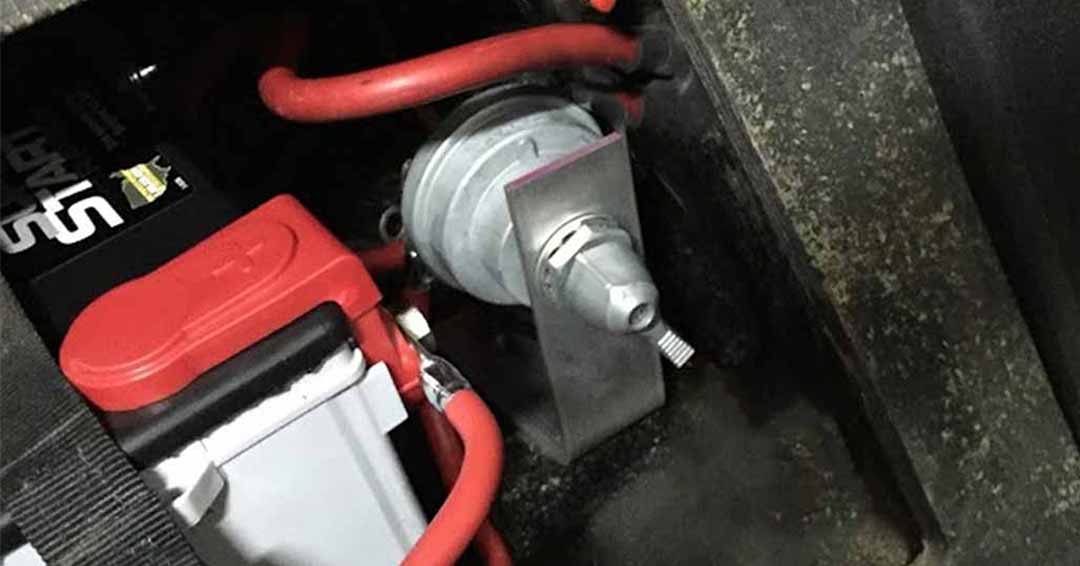
by Chris Miles Many DeLoreans suffer from vampiric battery drain if the car is parked for too long. How many times have you wanted to take the DeLorean out for a drive, just to turn the key and find out your battery is dead? The battery cut off switch is not a new idea. However, some of us probably have an inexpensive switch that we just live with. Others don’t have one at all. While it’s best to make sure you don’t have some underlying issue, a battery cut off switch will prevent your battery from draining if you do not operate your car regularly. Especially for owners who store their cars in the winter, a battery cut of switch is almost a must. It’s also a convenient way to disconnect the battery whenever you want to work on the car. I never like messing with the battery cables if I don’t have to. With a battery cut off switch it may also eliminate the need to have your car on a trickle charger. The Pollak Master Disconnect Switch is my favorite, as it’s a very heavy duty battery cut off switch that outperforms your run of the mill switch from Harbor Freight, or your favorite discount auto parts store. Pollak has been manufacturing these switches for many, many years. Over the span of production they have been made in the USA, Mexico, India, and most recently Taiwan. If you watch eBay, you can usually find New Old Stock USA made Pollak switches. Just beware of the cheaper Chinese knockoffs, as they do not have the Pollak stamp on them. Over the years many people have installed these switches by drilling a hole through the battery access door. I am not the biggest fan of doing this because I don’t want to damage the original battery cover. Or, the switch could rub or dig into the back of the passenger seat, which is more costly to repair/replace. I prefer to make a bracket to mount the switch inside the battery cubby. You will also need to buy one 2 foot battery cable to run between the battery and the switch. You can pick one of these up at your favorite auto parts stores, or on Amazon or from O’Reilly Auto Parts. For installation, I connect the positive battery cable to one stud on the switch. I then run the new 2 foot battery cable to the other stud.
DeLorean RPM Relay
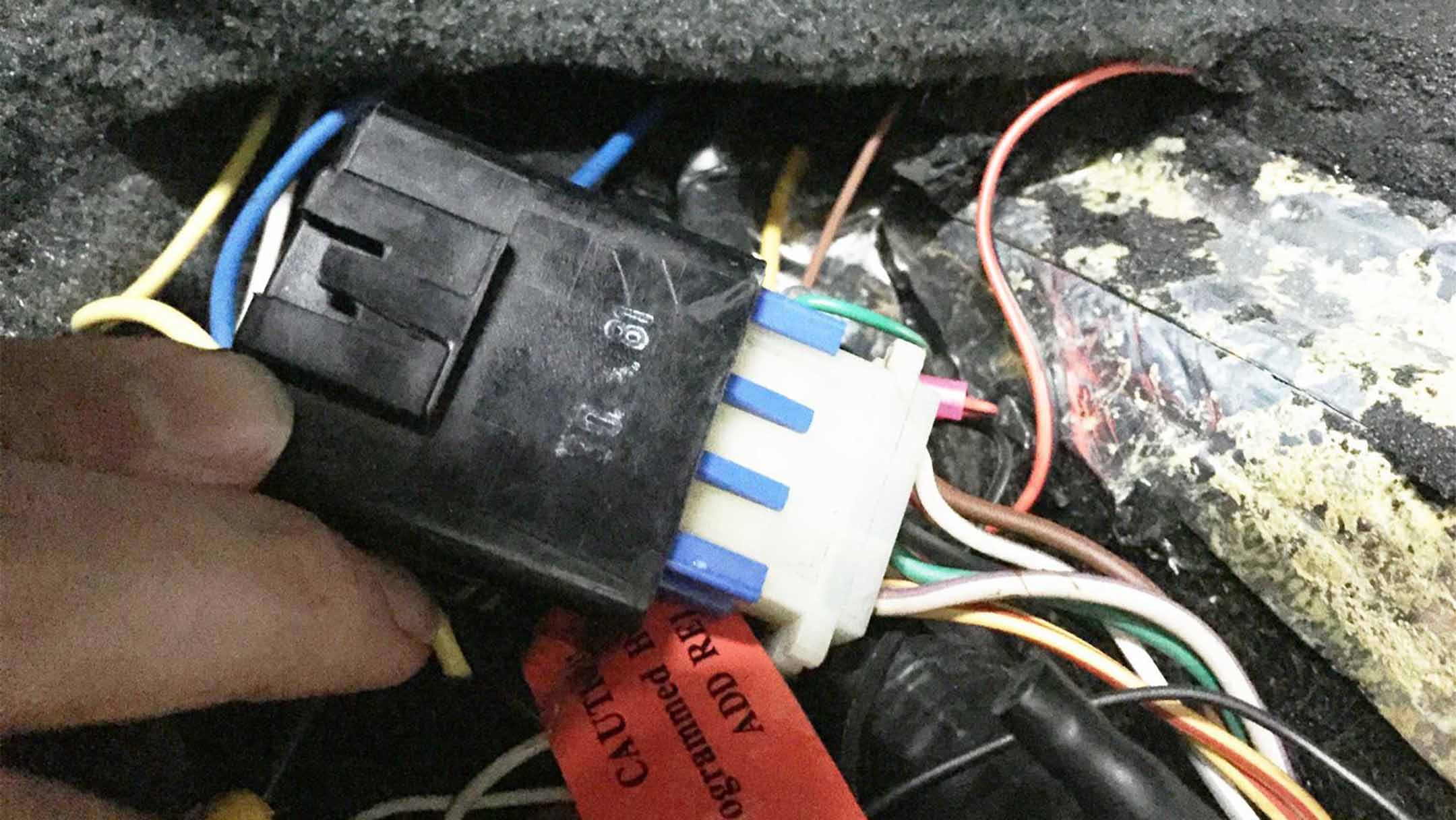
by Chris Miles The RPM relay is essential for fuel pump operation. It powers the fuel pump when it detects an RPM signal, meaning there’s an ignition signal, and the engine is turning over. It’s a black six pin relay usually found mounted to the underside of the relay tray behind the passenger seat. Or, just look for the large relay similar to this photo. If the relay fails, you can be left stranded, and you likely won’t get a warning of a failing RPM relay ahead of time. To avoid RPM relay issues, I recommend buying Dave McKeen’s solid state RPM relay (https://dm-eng.weebly.com – use the “Contact Email” link at the top of his page for pricing). Unlike the original RPM relay, McKeen’s solid state relay runs cool and will essentially last forever. Since the RPM relay is essential for running the car, why rely on a 30+ year old piece of technology. Dave will rebuild your original relay with solid state components, or you can send him a compatible relay to rebuild. Search eBay and other websites for Volvo relays. You can also go to junkyards and search for 1980s Volvos (commonly Volvo 240s) for compatible relay cores. If you send McKeen one of the Volvo relays, you can keep your original DMC relay as a spare. Alternatively, please see my for sale link here (RPM Relay Core),if you would like to buy a relay core from me. This photo gives you an idea of what to look for on the INSIDE of the Volvo relays. Make sure the pins “stacked” when they attach to the circuit board. Other relays cannot be re-used for McKeen’s conversion. I’ve been using these relays in both of my DeLoreans since about 2010 and they work great. If you don’t want to spend the money for McKeen’s relay, it’s not a bad idea to make a three-wire lead you can use to jumper the RPM relay socket in case of emergency. The three wires are all connected to each other at the top (so that they make a single circuit,) and when plugged in as the photo shows, the fuel pump circuit will be powered – allowing you to get home and buy a new RPM relay.
DeLorean Alternator Tensioner
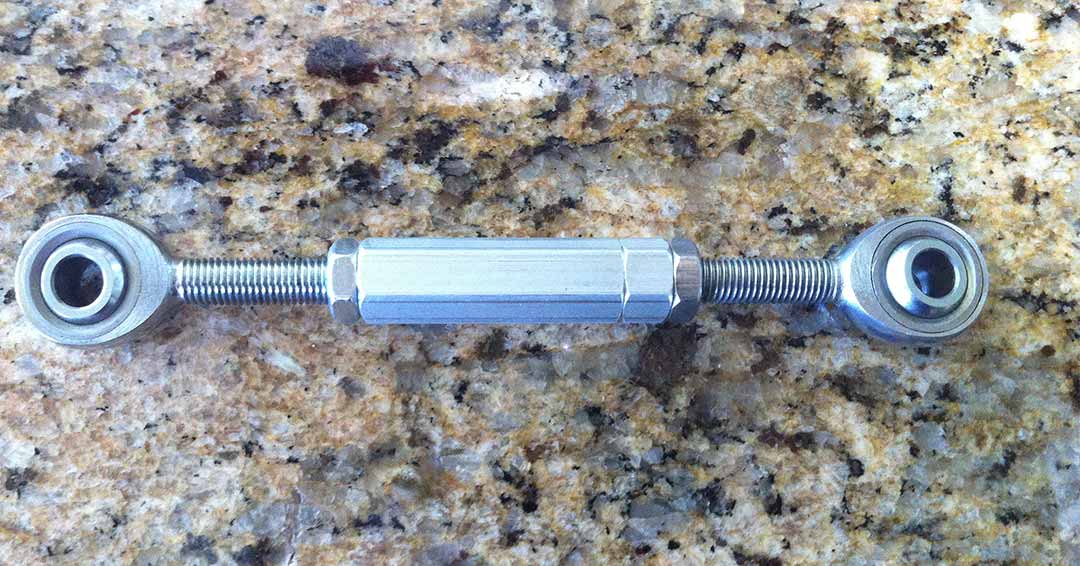
by Chris Miles If you’ve ever had to replace the alternator / water pump belt (or just adjust it,) you know what a pain it is – especially if you’re broken down on the side of the road! So, to make it easier, I have been using a turnbuckle style alternator tensioner. It’s made from parts sourced from McMaster Carr. You don’t need to install this now, but it’s a good idea to have it in your car, so that you can install it the next time you replace the belt. (You SHOULD have a spare belt in the car too – Gates #7495 – www.rockauto.com/en/moreinfo.php?pk=3913&jsn=10393) You’ll be replacing the existing alternator tensioner bracket (DMCT Part#: 110102) with this new tensioner. Here are the parts you’ll need to build this replacement bracket: Remember, you’ll also need a long enough bolt to go through the rod end into the alternator itself. Check your YOUR alternator bolt size, and get one about 1/2″ longer than the current size. The coupler accepts a ½ inch open-end wrench. Simply rotate the coupler to extend the tensioner, which pushes the alternator away from the water pump pulley, thus tightening the belt. I’ve been using these on both of my DeLoreans for years, and have never had an adjustment problem. At the time of this writing, the rod ends were about $14 each, and the coupler nut was $18. The jam nuts are probably less than $1 each. For about $50, you can have piece of mind that you can replace your broken or damaged alternator belt on the side of the road quickly and easily.
ASI Radio User Manual
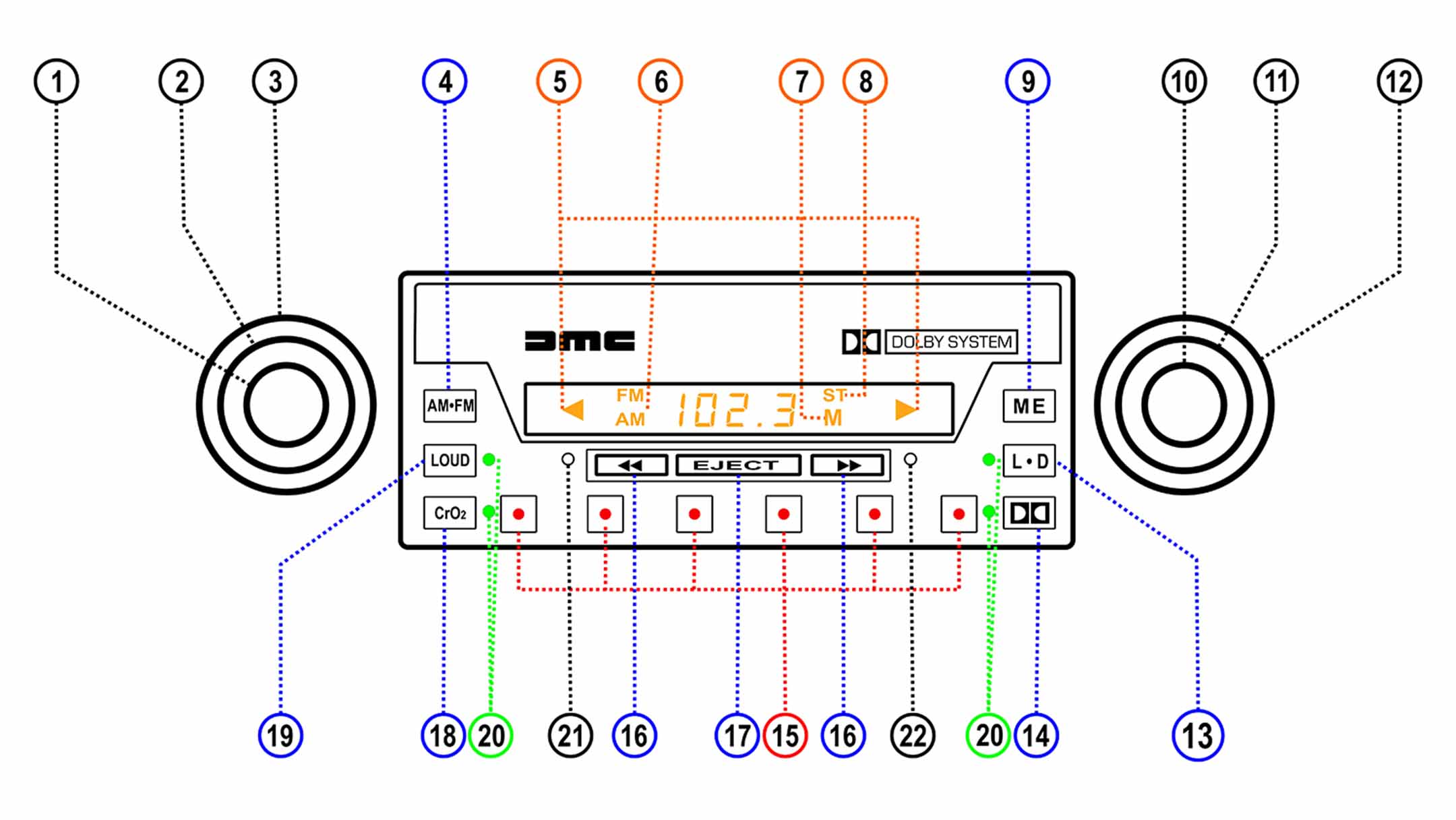
Thanks to the DeLorean community, someone out there scanned a copy of the ASI radio user manual. But, the original quality of the manual wasn’t great, so we recreated it, along with the legend map. Please do re-share and pass this around. After reading the manual, it looks like Audio Systems Inc. radio was kinda ‘high-tech’ for the day. And now you’ve ever wondered how to set the clock or what happens when you push the left knob in, here ya go. Click the cover photo for a PDF that is print-ready as a booklet, so you can print on your home printer, or at Kinko’s. Text version of the ASI manual AUDIO SYSTEMS, INC. RADIO OPERATION TO TURN TAPE PLAYER ON (1)The ON-OFF switch is combined with the VOLUME control, both of which, are operated by the front knob. Turn this knob clockwise until a “click” is heard, which indicates that the radio is now “ON”. Further clockwise rotation will increase the volume. AM / FM SELECTION (4)The desired broadcast band is selected by the “AM / FM” Selector Button which is the button marked “AM / FM”. The radio has the FM and AM band indicators (6) located to the left of the Radio Frequency display and the appropriate indicator will light up depending on whether FM or AM band is operating. MANUAL STATION TUNING (10)This radio is equipped with an electronic tuner. To tune to a station manually rotate the right front knob clockwise for up scale tuning and counterclockwise for down scale tuning. The frequency will appear on the digital display area of the radio. On the AM band the frequency will appear in the steps of 10 KHz and on the FM band the frequency will appear in steps of 0.2 MHz. Each “click” while rotating the manual tuning knob will be one step on the respective broadcast band. Tune the set carefully until you are exactly on the station. This FM receiver is equipped with an automatic muting circuit. This circuit filters out virtually all off station background noise when tuning from station to station. Also, when background noise is greater than the transmitted station signal, both the station signal and background noise are muted (filtered) out. SEEK TUNING (1)The SEEK tuning feature of this radio automatically locates the next strong station available on the radio dial when actuated. This feature operates in the up scale direction. The SEEK tuning feature is activated by pushing in the left front knob when in the radio mode. The radio automatically locates the next strong station and stops. This procedure can be repeated by pushing the left front knob again. Repeat until the desired station is being received. For maximum sensitivity of Seek Tuning feature, the L/D button (12) should be in the distant position. TUNING PUSHBUTTONS (15)Each tuning pushbutton can be set to two stations, one on the AM band and one on the FM band. This provides a total of twelve stations which can be selected by pushbutton operation. Each tuning pushbutton also has a dual color LED light in its center. These lights allow the user to easily locate each pushbutton at night. The lights change from red to green to indicate the last pushbutton operated. MEMORY (9)Set pushbuttons as follows:1. Select the desired broadcast band with the AM/FM selector button (4).2. Carefully tune to the desired station with the manual tuning control (10) or by using the SEEK tuning feature (1).3. Press the top right button marked “ME” for approximately ¾ second until the orange color “M” appears on the display area (7).4. Press one of the tuning push buttons. The “M” on the display area will go out indicating the button is now preset to this station.5. Repeat steps 2-4 for the remaining buttons.6. Set the AM/FM selector button (4) to the other broadcast band and set the six push buttons in the same manner as above. NOTE: THE ELECTRONIC CONTROL FUNCTIONS IN THE RADIO WILL NOT OPERATE PROPERLY IF POWER TO THE RADIO IS INTERRUPTED. THE POWER INTERRUPTION COULD BE CAUSED BY DISCONNECTION OF THE BATTERY, OR LOW BATTERY VOLTAGE AS MAY OCCUR IN COLD WEATHER STARTING. DISCONNECTION OF THE BATTERY WILL CAUSE LOSS OF PUSHBUTTON STATION MEMORY AND THE TIME. THE MEMORY AND CLOCK WILL REQUIRE RESETTING WHEN POWER IS RESTORED. LOW BATTERY VOLTAGE WILL CAUSE FAILURE IN THE SEEK TUNING OPERATION. THE SEEK TUNING WILL OPERATE PROPERLY WHEN POWER IS RESTORED. STEREO INDICATOR LIGHT (8)An FM Stereo light, “ST”, is located on the right side of the display area. This light will glow whenever the radio is tuned to an FM stereo station who’s broadcasting signal is of sufficient strength. If the stereo signal begins to weaken the radio will automatically blend to monaural reception. The mono mode will increase the radio’s ability to receive the weak signal. As the signal strength returns to a sufficient level the radio will automatically return to the Stereo mode. LOCAL / DISTANT SELECTOR (13)The center button on the right side of the radio marked “L/D” is the Local/Distant Selector. When the small green indicator light is on, the radio in the ‘Distant’ mode. When the indicator light is off, the radio is in the ‘Local’ mode. This which allows the user to discriminate the strong (‘Local’ position) from week stations (‘Distant’ position) in the FM mode. When the radio is in the Seek Tuning mode, this feature allows the user to discriminate the strong stations from week stations on both the am and FM bands. Your radio should be in the ‘DISTANT’ mode for the best reception under most conditions, an exception would be in an urban area with tall buildings. TREBLE CONTROL (2)The trouble response can be adjusted to the desired level with the middle knob on the left side of the radio. Rotating clockwise increases the treble and rotating counterclockwise decrease is the response. There is a detent Position at the middle point of the knob’s rotation. BALANCE CONTROL
DeLorean A-Pillar Restoration

by Matt Kerns, VIN #03650 When I bought my car from upstate NY, the interior A-pillar windshield trim was deformed, pulling away, and the vinyl was hard and cracking. I decided to reshape and recover them rather than buy new ones. Steps: Remove the pillar trim by cutting the vinyl holding it to the car. I chose to remove the windshield and bracing the roof to properly remove and install the new trim, like factory gluing the vinyl, particularly under the glass. After separation, I stripped them of covering and glue, cleaning the plastic with acetone, MEK, mineral spirits, and whatever wouldn’t harm the plastic. To reshape the warped plastic, I clamped the flat side between two 1″x1″ pieces of wood, heating as I went with a low-to-medium setting on a heat gun. When I was done reforming, I left the pieces clamped for a couple days to ensure no spring back. I then traced the flat portion that was now reshaped, onto cardboard as a template, so I could transfer it to a thin 0.032 inch stiff aluminum sheet metal. I cut out the metal backing plate I just made, then glued / bonded it to the inside of the A-pillar trim using rubber cement (or any desired glue.) Note: The stock metal angle plate where the trim meets the dash is still used in conjunction with the new plate I just made, and should not be overlapped, as this will add thickness. Butt joint the two pieces. Take your desired covering material (I used automotive grade, one-way stretch-backed vinyl) and cover the plastic pillar, leaving about an inch overlap on the both sides, to wrap and glue under the windshield and under the door jamb where the door gasket fits over it. Let the glue dry completely to make sure it does not peel away from the trim piece. Dry fit the pillar on the car, wrapping the flat side-flap around/over where the glass would be, cutting the excess material off. (It should be about half-way along the frame, so about half-an-inch of material and half-an-inch of windshield surface for gluing, like the OEM.) Trimming Not pictured. I Used 3M double-sided foam tape to secure the trim to the car, sandwiched between the car and the metal plate I glued in. Use your desired glue to bond the flap to the frame (I used rubber cement.) Use Windshield glue to reinstall the windshield. *Remember to use the depth blocks to allow the right height for the shield to the body. Press on the door gaskets that overlap the vinyl and glue the vinyl to the door jamb. (I also added vinyl trim to the top of the windshield where it meets roof and headliner.) Photos:
EZ-er DeLorean Oil Changes

by Chris Miles There comes a time in DeLorean ownership when you want to make maintenance tasks more convenient. After many years of ownership certain tasks because a hassle, like changing the oil. As most of us know, the stock oil drain plug is a bit of an odd duck. It takes a specially tool to remove the plug. This is especially troublesome if you elect to take the car to a shop to get an oil change. Not only do you need to carry the tool with you, you have to explain to the shop techs not to wrench down on the plug. One of the coolest upgrades I’ve come across for the car is the “EZ Oil drain valve”, sold by Toby Petersen at DeLorean Parts Northwest. It replaces the stock oil pan plug with a convenient valve that allow you to drain your oil effortlessly. No longer do you have to worry about special tools, copper crush washers, or stripping the drain plug socket.Toby has teamed up with EZ drain valve people to come up with a kit especially for the DeLorean. When you get the kit, you’ll find the valve body, an adapter, and two blue fiber washers. Once it’s all assembled on the car you should have a tight seal with no leaks. Due to the limited space between the oil pan and the frame crossmember, it’s a tight fit, but it all works. Once the valve is fitted, you won’t have to mess with it again. [flickr_tags tags=”post-3637″]
DeLorean Owner’s Handbook

The DeLorean Owner’s Handbook below is the 1982 version. Learn more about the other versions of the DeLorean Owners Manuals.
Hi-Resolution DeLorean Relay and Fuse diagram
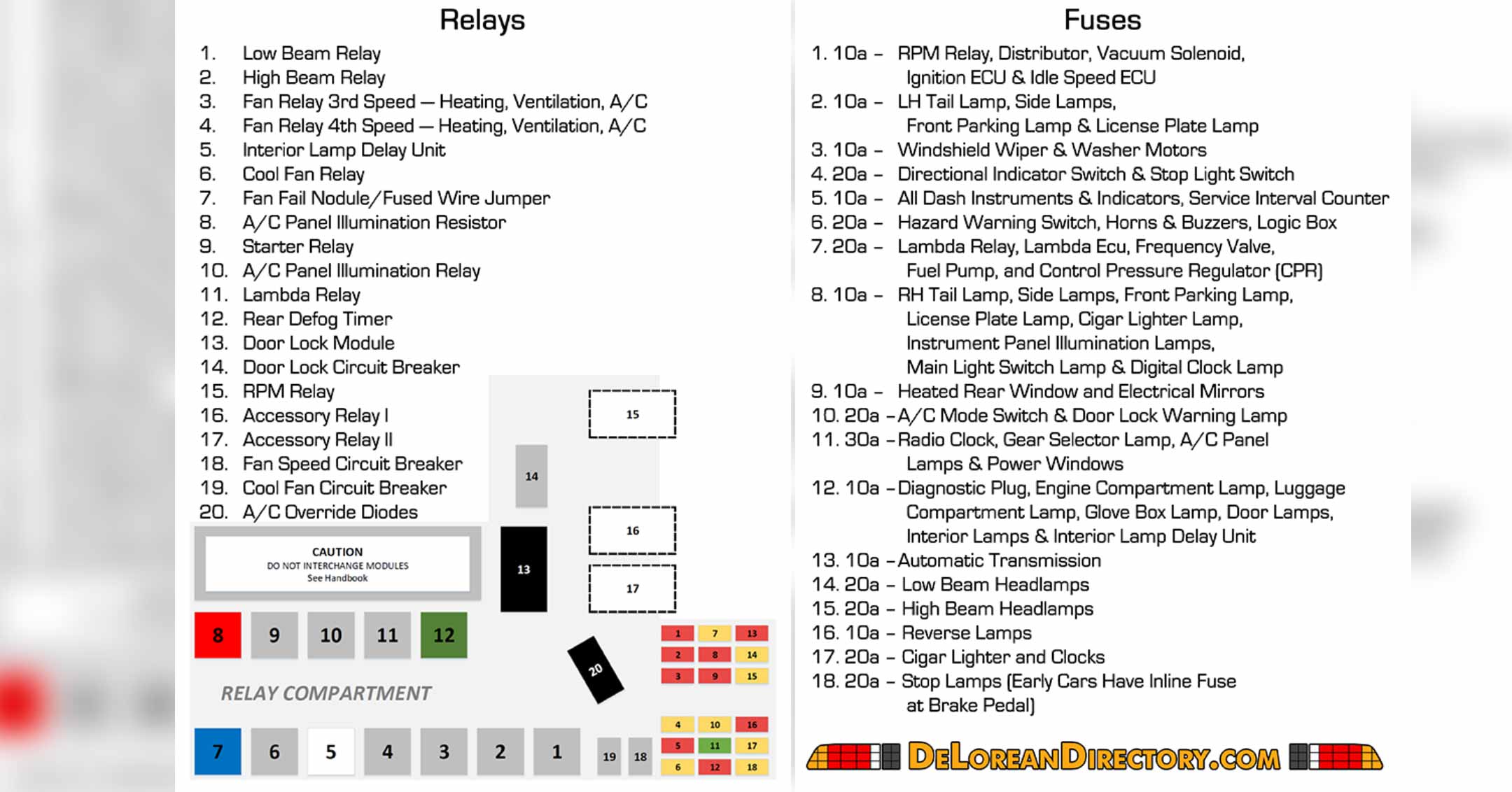
A hi-res, full-page printable DeLorean relay and fuse diagram. (Click here for PDF version.)


